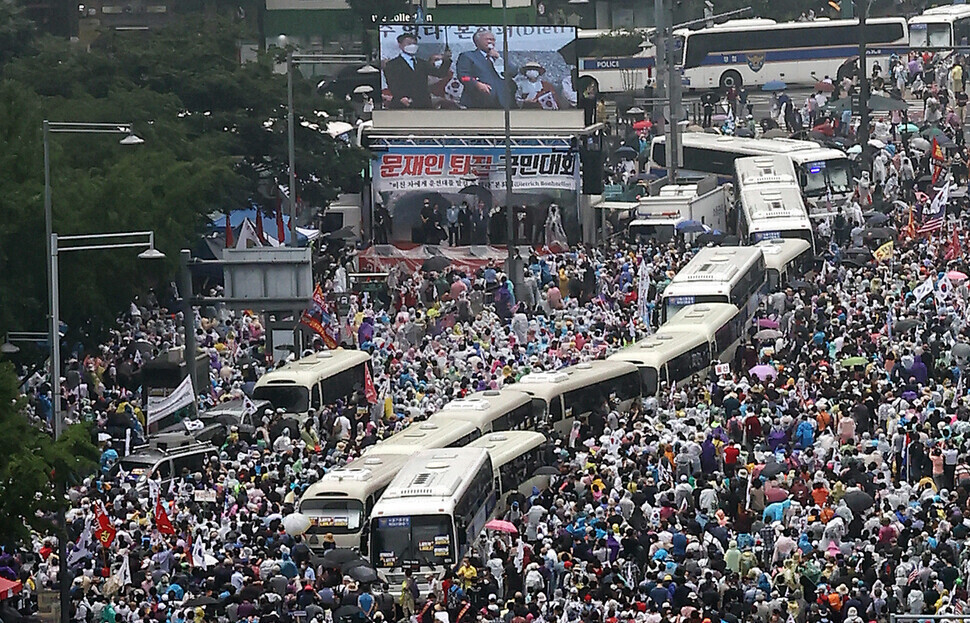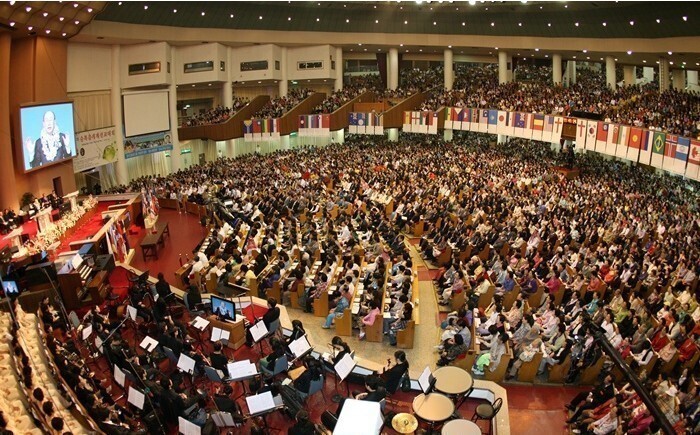hankyoreh
Links to other country sites 다른 나라 사이트 링크
[News analysis] Why COVID-19 outbreaks keep occurring at S. Korea’s protestant churches?

Catholic cathedrals hold Sunday masses with large numbers of people in attendance. Buddhist temples hold dharma meetings. Yet it is specifically protestant churches that account for large numbers of patients diagnosed with COVID-19 in South Korea. Why should that be?
While there would seem to be little difference among religions in the way that assembly facilities are operated, a closer examination tells a different story. In explanations of religion in South Korea, Catholic priests are often likened to “government employees,” Buddhist monks to “public enterprise staff,” and Protestant ministers to “the self-employed.” Priests are situated beneath the safety valve of a centralized organization that goes from the Vatican to the dioceses and on to individual cathedrals; like government employees, they don’t need to focus too much on individual results. They don’t browbeat congregation members into coming to mass every time or press them for contributions.
In the case of Buddhism -- where the Jogye Order predominates – the system is again centralized with a hierarchy extending down from headquarters to districts, temples, and hermitages. But it is not as strict as in the Catholics’ case. Pursuing liberation by nature, monks shun constraints and are relatively loose about managing their followers.
Every protestant church for itselfIn contrast, Protestant churches are divided into hundreds of denominations, each with strong ecclesiastical characteristics. With each church’s survival dependent on its minister’s capabilities, missionary efforts are a matter of life or death. The energies dedicated to managing congregations, evangelizing, and collecting contributions are incomparably greater than in other religions. This explains why every time the South Korean government has imposed restrictions on religious establishments to contain COVID-19, Catholics and Buddhists have complied without a whisper, while Protestants have groused about why “church gatherings are being barred while restaurants, bars, and coffee shops are left alone.”
South Korean churches are also fervent to a degree that startles even Christians in other countries. Congregation members gather early in the morning to give morning prayers at their churches and dine together after services. It’s a situation not found at churches in other countries. The morning prayers in particular echo aspects of Korean folk faiths, where a bowl of fresh water would be poured on a crock stand or in the kitchen each morning to say prayers. The communal meals were originally a Buddhist temple practice, but as more and more churches have built cafeterias, an increasing number have had meals after services.
In this sense, Korean protestants carry on the tradition of gathering in a parlor to share fellowship. The joint reciting of prayers so common in Korean churches can also be found in US Southern Baptist churches and in Africa, but is rare in Europe or elsewhere in Asia. Additionally, churches tend to have larger numbers of members per unit of building area -- so that when members remove their masks to sing hymns, pray, or eat together in small gatherings, the likelihood of droplets being spread is higher. Megachurches in particular are organized under a “cell” format combining smaller districts in the range of 10 households and larger districts in the range of 100 households. The members have meetings several times a week, resulting in an incomparably greater frequency of contact than in other religions.

After the virus outbreak last February centering on the Shincheonji religious sect in Daegu, most established churches followed government disease prevention guidelines by reducing the number of service participants to allow for “distancing” and offering online services in tandem. Yoido Full Gospel Church -- the world’s single largest with a congregation of 560,000 members -- had an average of 12,000 people attending 9 am and 11 am services among its seven Sunday divisions; since February, that number has fallen to a tenth of its previous level. Sae Eden Presbyterian Church in Yongin, Gyeonggi Province, which has six Sunday services, saw its number of attendees plummet from the 4,000 to 6,000 range per service to the 500 to 1,000 range.
Churches and ministers are deeply concerned about the possibility of losing some congregation members as a result. This sense of urgency was reflected in the move by the United Christian Churches of Korea (UCCK) to designated May 31 as the “day of restoring services at Korean churches” and holding a campaign to have “all congregation members come to church for services like before.”
“Not only have church finances deteriorated as the number of attendees and contributions have diminished, but while the majority of churches are abiding by disease prevention guidelines and refraining from small gatherings and meals, some of the churches are staging revivals and retreats where people are passionately singing hymns and praying and eating together, which has a negative impact on the rest of the churches,” explained one UCCK-affiliated minister.
Churches may have emerged as the epicenter for the recent spread of COVID-19 -- but it’s also churches that are counting themselves among the biggest victims of the pandemic and praying for things to quickly return to the way they were before the virus.
By Cho Hyun, religion correspondent
Please direct comments or questions to [english@hani.co.kr]

Editorial・opinion
![[Editorial] Yoon must halt procurement of SM-3 interceptor missiles [Editorial] Yoon must halt procurement of SM-3 interceptor missiles](https://flexible.img.hani.co.kr/flexible/normal/500/300/imgdb/child/2024/0501/17145495551605_1717145495195344.jpg) [Editorial] Yoon must halt procurement of SM-3 interceptor missiles
[Editorial] Yoon must halt procurement of SM-3 interceptor missiles![[Guest essay] Maybe Korea’s rapid population decline is an opportunity, not a crisis [Guest essay] Maybe Korea’s rapid population decline is an opportunity, not a crisis](https://flexible.img.hani.co.kr/flexible/normal/500/300/imgdb/original/2024/0430/9417144634983596.jpg) [Guest essay] Maybe Korea’s rapid population decline is an opportunity, not a crisis
[Guest essay] Maybe Korea’s rapid population decline is an opportunity, not a crisis- [Column] Can Yoon steer diplomacy with Russia, China back on track?
- [Column] Season 2 of special prosecutor probe may be coming to Korea soon
- [Column] Park Geun-hye déjà vu in Yoon Suk-yeol
- [Editorial] New weight of N. Korea’s nuclear threats makes dialogue all the more urgent
- [Guest essay] The real reason Korea’s new right wants to dub Rhee a founding father
- [Column] ‘Choson’: Is it time we start referring to N. Korea in its own terms?
- [Editorial] Japan’s rewriting of history with Korea has gone too far
- [Column] The president’s questionable capacity for dialogue
Most viewed articles
- 1Months and months of overdue wages are pushing migrant workers in Korea into debt
- 2Trump asks why US would defend Korea, hints at hiking Seoul’s defense cost burden
- 3At heart of West’s handwringing over Chinese ‘overcapacity,’ a battle to lead key future industries
- 4[Editorial] Yoon must halt procurement of SM-3 interceptor missiles
- 5[Guest essay] Maybe Korea’s rapid population decline is an opportunity, not a crisis
- 6Fruitless Yoon-Lee summit inflames partisan tensions in Korea
- 7Dermatology, plastic surgery drove record medical tourism to Korea in 2023
- 8First meeting between Yoon, Lee in 2 years ends without compromise or agreement
- 91 in 3 S. Korean security experts support nuclear armament, CSIS finds
- 10AI is catching up with humans at a ‘shocking’ rate